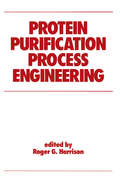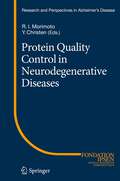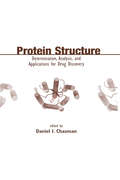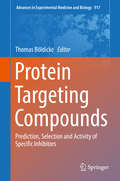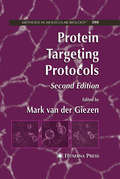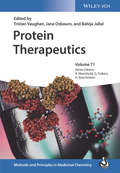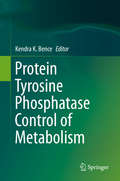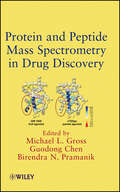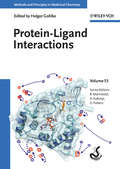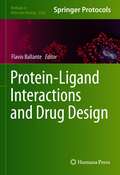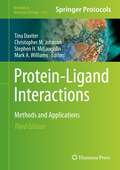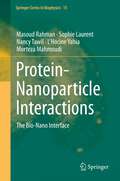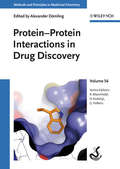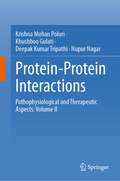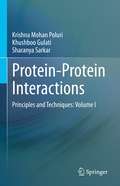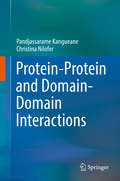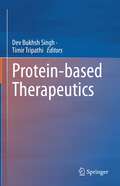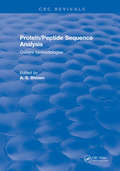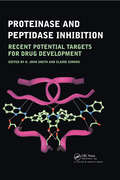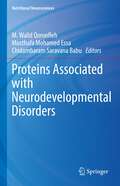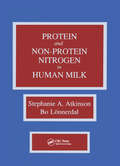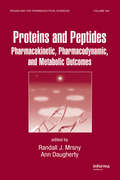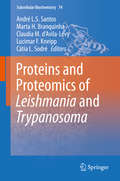- Table View
- List View
Protein Purification Process Engineering
by Roger G. HarrisonOffers coverage of the development of protein purification processes for large-scale commercial operations, and addresses process development, scale-up, applications and mathematical descriptions. Technologies currently used at the commercial scale are covered in depth.
Protein Quality Control in Neurodegenerative Diseases
by Yves Christen Richard I. MorimotoThe health of the proteome depends upon protein quality control to regulate the proper synthesis, folding, translocation, and clearance of proteins. The cell is challenged constantly by environmental and physiological stress, aging, and the chronic expressions of disease associated misfolded proteins. Substantial evidence supports the hypothesis that the expression of damaged proteins initiates a cascade of molecular events that leads to Alzheimer's disease, Parkinson's disease, amyotrophic lateral sclerosis, Huntington's disease, and other diseases of protein conformation.
Protein Structure: Determination, Analysis, and Applications for Drug Discovery
by Daniel I. ChasmanThis text offers in-depth perspectives on every aspect of protein structure identification, assessment, characterization, and utilization, for a clear understanding of the diversity of protein shapes, variations in protein function, and structure-based drug design. The authors cover numerous high-throughput technologies as well as computational met
Protein Targeting Compounds
by Thomas BöldickeThis book presents an overview of the most relevant protein knockdown techniques. Readers will find a description of the generation and use of recombinant human antibodies, ER intrabodies and peptides as well as a description of the working mechanism and potential of the inhibitory action of each of these molecules. The book will also describe the selection and activity of a number of phosphatases, aptamers and allosteric modulators, focusing on A G protein coupled receptors. The book starts with a chapter on the in silico prediction of target-inhibitor interactions. Key aspects of this book are: - Selection strategies for monoclonal and recombinant human antibodies - Selection strategies for ER intrabodies, peptides and aptamers - Examples of the most efficient inhibitors and their applications in protein biochemistry and cell biology - Antibodies for cancer therapy and inhibitors of angiogenesis. The book will be of great interest to scientists and students working in the life sciences on all areas related to protein biology. The variety of methods to modulate the activities of specific proteins which are introduced here will be of great benefit to the reader who is interested in general protein research or to readers who have very specific protein related questions.
Protein Targeting Protocols
by Mark Van GiezenIn this updated volume, experts from around the world provide the latest protocols for isolating different organelles and the localization of particular proteins using a variety of methods such as light, confocal, and electron microscopy. Emphasis is placed on protein targeting of cellular compartments in both prokaryotic and eukaryotic systems. The book includes targeting protocols from different systems.
Protein Therapeutics
by Raimund Mannhold Gerd Folkers Helmut Buschmann Bahija Jallal Jane Osbourn Tristan VaughanIn this practice-oriented two volume handbook, professionals from some of the largest biopharmaceutical companies and top academic researchers address the key concepts and challenges in the development of protein pharmaceuticals for medicinal chemists and drug developers of all trades. Following an introduction tracing the rapid development of the protein therapeutics market over the last decade, all currently used therapeutic protein scaffolds are surveyed, from human and non-human antibodies to antibody mimetics, bispecific antibodies and antibody-drug conjugates. This ready reference then goes on to review other key aspects such as pharmacokinetics, safety and immunogenicity, manufacture, formulation and delivery. The handbook then takes a look at current key clinical applications for protein therapeutics, from respiratory and inflammation to oncology and immune-oncology, infectious diseases and rescue therapy. Finally, several exciting prospects for the future of protein therapeutics are highlighted and discussed.
Protein Tyrosine Phosphatase Control of Metabolism
by Kendra K. BenceAlthough phosphorylation of proteins on tyrosine is relatively rare compared to phosphorylation on serine or threonine residues, the past two decades of research into PTP function have led to a great appreciation of the critical role PTPs have in regulating basic cellular processes. Among these important roles is the regulation of cellular signaling pathways related to metabolism. This volume contains chapters which highlight many aspects of PTP function in the context of metabolism. Given the growing obesity and diabetes epidemics in the United States and throughout the world, the desire to identify possible therapeutic targets for treatment of these diseases is a high priority. In many ways, PTPs may be attractive drug targets since they are amenable to targeting with small molecules; however many challenges abound in making PTP inhibitors.
Protein Tyrosine Phosphatases in Cancer
by Benjamin G. Neel Nicholas K. TonksThis book aims to bridge the gap in understanding how protein-tyrosine phosphatases (PTPs), which carry out the reverse reaction of tyrosine phosphorylation, feature in cancer cell biology. The expertly authored chapters will first review the general features of the PTP superfamily, including their overall structure and enzymological properties; use selected examples of individual PTP superfamily members, to illustrate emerging data on the role of PTPs in cancer; and will review the current status of PTP-based drug development efforts. Protein Tyrosine Phosphatases in Cancer,from renowned researchers Benjamin Neel and Nicholas Tonks, is invaluable reading for researchers in oncology, stem cell signaling,and biochemistry.
Protein and Peptide Mass Spectrometry in Drug Discovery
by Guodong Chen Michael L. Gross Birendra N. PramanikThe book that highlights mass spectrometry and its application in characterizing proteins and peptides in drug discovery An instrumental analytical method for quantifying the mass and characterization of various samples from small molecules to large proteins, mass spectrometry (MS) has become one of the most widely used techniques for studying proteins and peptides over the last decade. Bringing together the work of experts in academia and industry, Protein and Peptide Mass Spectrometry in Drug Discovery highlights current analytical approaches, industry practices, and modern strategies for the characterization of both peptides and proteins in drug discovery. Illustrating the critical role MS technology plays in characterizing target proteins and protein products, the methods used, ion mobility, and the use of microwave radiation to speed proteolysis, the book also covers important emerging applications for neuroproteomics and antigenic peptides. Placing an emphasis on the pharmaceutical industry, the book stresses practice and applications, presenting real-world examples covering the most recent advances in mass spectrometry, and providing an invaluable resource for pharmaceutical scientists in industry and academia, analytical and bioanalytical chemists, and researchers in protein science and proteomics.
Protein-Ligand Interactions (Methods and Principles in Medicinal Chemistry #53)
by Raimund Mannhold Gerd Folkers Hugo KubinyiInnovative and forward-looking, this volume focuses on recent achievements in this rapidly progressing field and looks at future potential for development. The first part provides a basic understanding of the factors governing protein-ligand interactions, followed by a comparison of key experimental methods (calorimetry, surface plasmon resonance, NMR) used in generating interaction data. The second half of the book is devoted to insilico methods of modeling and predicting molecular recognition and binding, ranging from first principles-based to approximate ones. Here, as elsewhere in the book, emphasis is placed on novel approaches and recent improvements to established methods. The final part looks at unresolved challenges, and the strategies to address them. With the content relevant for all drug classes and therapeutic fields, this is an inspiring and often-consulted guide to the complexity of protein-ligand interaction modeling and analysis for both novices and experts.
Protein-Ligand Interactions and Drug Design (Methods in Molecular Biology #2266)
by Flavio BallanteThis detailed book collects modern and established computer-based methods aimed at addressing the drug discovery challenge from disparate perspectives by exploiting information on ligand-protein recognition. Beginning with methods that allow for the exploration of specific areas of chemical space and the designing of virtual libraries, the volume continues with sections on methods based on docking, quantitative models, and molecular dynamics simulations, which are employed for ligand discovery or development, as well as methods exploiting an ensemble of protein structures for the identification of potential protein targets. Written for the highly successful Methods in Molecular Biology series, chapters include introductions to their respective topics, lists of the necessary materials, step-by-step, readily reproducible laboratory protocols, and tips on troubleshooting and avoiding known pitfalls. Authoritative and cutting-edge, Protein-Ligand Interactions and Drug Design provides detailed practical procedures of solid computer-aided drug design methodologies employed to rationalize and optimize protein-ligand interactions, for experienced researchers and novices alike.
Protein-Ligand Interactions: Methods and Applications (Methods in Molecular Biology #2263)
by Mark A. Williams Tina Daviter Christopher M. Johnson Stephen H. McLaughlinThis third edition provides new and updated chapters detailing a complete introduction to common and emerging procedures for characterizing the interactions of individual proteins with their natural ligands, drugs or other binding partners. Chapters detail natural substrates, potential drug leads, quantitative understanding of the mechanism of interaction, and different techniques. Written in the highly successful Methods in Molecular Biology series format, chapters include introductions to their respective topics, lists of the necessary materials and reagents, step-by-step, readily reproducible laboratory protocols, and tips on troubleshooting and avoiding known pitfalls. Authoritative and accessible, Protein Ligand Interactions: Methods and Applications, Third Edition serves as an ideal guide for researchers new to the field of biophysical characterization of protein interactions.
Protein-Nanoparticle Interactions: The Bio-Nano Interface
by Morteza Mahmoudi Masoud Rahman Nancy Tawil Sophie Laurent L'Hocine YahiaIn recent years, the fabrication of nanomaterials and exploration of their properties have attracted the attention of various scientific disciplines such as biology, physics, chemistry, and engineering. Although nanoparticulate systems are of significant interest in various scientific and technological areas, there is little known about the safety of these nanoscale objects. It has now been established that the surfaces of nanoparticles are immediately covered by biomolecules (e.g. proteins, ions, and enzymes) upon their entrance into a biological medium. This interaction with the biological medium modulates the surface of the nanoparticles, conferring a "biological identity" to their surfaces (referred to as a "corona"), which determines the subsequent cellular/tissue responses. The new interface between the nanoparticles and the biological medium/proteins, called "bio-nano interface," has been very rarely studied in detail to date, though the interest in this topic is rapidly growing. In this book, the importance of the physiochemical characteristics of nanoparticles for the properties of the protein corona is discussed in detail, followed by comprehensive descriptions of the methods for assessing the protein-nanoparticle interactions. The advantages and limitations of available corona evaluation methods (e.g. spectroscopy methods, mass spectrometry, nuclear magnetic resonance, electron microscopy, X-ray crystallography, and differential centrifugal sedimentation) are examined in detail, followed by a discussion of the possibilities for enhancing the current methods and a call for new techniques. Moreover, the advantages and disadvantages of protein-nanoparticle interaction phenomena are explored and discussed, with a focus on the biological impacts.
Protein-Protein Interactions in Drug Discovery
by Raimund Mannhold Gerd Folkers Hugo Kubinyi Alexander DömlingTreating protein-protein interactions as a novel and highly promising class of drug targets, this volume introduces the underlying strategies step by step, from the biology of PPIs to biophysical and computational methods for their investigation. The main part of the book describes examples of protein targets for which small molecule modulators have been developed, covering such diverse fields as cancer, autoimmune disorders and infectious diseases. Tailor-made for the practicing medicinal chemist, this ready reference includes a wide selection of case studies taken straight from the development pipeline of major pharmaceutical companies to illustrate the power and potential of this approach.From the contents:* Prediction of intra- and inter-species protein-protein interactions facilitating systems biology studies* Modulators of protein-protein interactions: The importance of Three-Dimensionality* Interactive technologies for leveraging the known chemistry of anchor residues * SH3 Domains as Drug Targets* P53 MDM2 Antagonists: Towards Non Genotoxic Anticancer Treatments* Inhibition of LFA-1/ICAM interaction for treatment of autoimmune diseases* The PIF-binding pocket of AGC kinases* Peptidic inhibitors of protein-protein interactions for cell adhesion receptors* The REPLACE Strategy for generating Non-ATP competitive Inhibitors of Cell-Cycle Protein Kinasesand more
Protein-Protein Interactions: Pathophysiological and Therapeutic Aspects: Volume II
by Krishna Mohan Poluri Khushboo Gulati Deepak Kumar Tripathi Nupur NagarThe second volume of the book-Protein-Protein Interactions (PPIs) provides an overview of various protein-protein interactions (PPIs) that are involved in various human diseases including cancer, neurodegenerative diseases, immune diseases, and inflammation. It summarizes the structure and ligand-based drug designing approaches for the discovery of small molecules that can inhibit PPIs in these diseases. The book discusses different computational and experimental tools that are used to determine the anomalous interactions underlying the diseases. Lastly, it also reviews the classical interactions between pathogens and hosts that are responsible for the pathophysiology of infectious diseases.
Protein-Protein Interactions: Principles and Techniques: Volume I
by Krishna Mohan Poluri Khushboo Gulati Sharanya SarkarThis book provides a comprehensive overview of the fundamental aspects of protein-protein interactions (PPI), including a detailed account of the energetics and thermodynamics involved in these interactions. It also discusses a number of computational and experimental approaches for the prediction of PPI interactions and reviews their principles, advantages, drawbacks, and the recent developments. Further, it offers structural and mechanistic insights into the formation of protein-protein complexes and maps different PPIs into networks to delineate various pathways that operate at the cellular level. Lastly, it describes computational protein-protein docking techniques and discusses their implications for further experimental research. Given its scope, this book is a valuable resource for students, researchers, scientists, entrepreneurs, and medical/healthcare professionals.
Protein-Protein and Domain-Domain Interactions
by Pandjassarame Kangueane Christina NiloferThis book illustrates the importance and significance of the molecular (physical and chemical) and evolutionary (gene fusion) principles of protein-protein and domain-domain interactions towards the understanding of cell division, disease mechanism and target definition in drug discovery. It describes the complex issues associated with this phenomenon using cutting edge advancement in Bioinformatics and Bioinformation Discovery. The chapters provide current information pertaining to the types of protein-protein complexes (homodimers, heterodimers, multimer complexes) in context with various specific and sensitive biological functions. The significance of such complex formation in human biology in the light of molecular evolution is also highlighted using several examples. The chapters also describe recent advancements on the molecular principles of protein-protein interaction with reference to evolution towards target identification in drug discovery. Finally, the book also elucidates a comprehensive yet a representative description of a large number of challenges associated with the molecular interaction of proteins.
Protein-based Therapeutics
by Dev Bukhsh Singh Timir TripathiThis book provides an overview of the essential characteristics and clinical applications of therapeutic proteins against human diseases, including cancers, immune disorders, infections, and other diseases. It presents the latest advancements in protein engineering techniques for producing desirable therapeutic proteins. The book also covers the strategies used to formulate and deliver systemic therapeutic proteins, approved protein therapeutics and their targets, and pharmacogenetic biomarkers. Further, it discusses challenges associated with the clinical implications of therapeutic proteins, including safety, immunogenicity, protein stability, degradation, and efficacy. It illustrates the development of biosimilar antibodies, optimization strategies for producing biobetter antibodies, and presents fundamental concepts about biosuperior therapeutics. Lastly, it includes a discussion about protein-based vaccines against bacterial and viral infections.
Protein/Peptide Sequence Analysis: Current Methodologies
by A.S. BhownThis book is an attempt to provide in a single source current state-of-the-art methodologies for protein sequence analysis. It is hoped that these various chapters are presented in such a way that both the newcomer and the established protein chemist will find useful information and directions to new techniques. This book offers a rich array of techniques and methods for sequencing proteins and peptides. It should meet the expectations of investigators in protein chemistry who wish to update their knowledge of sequencing techniques, and of those who wish to reacquaint themselves with the best available current technologies.
Proteinase and Peptidase Inhibition: Recent Potential Targets for Drug Development
by H. John Smith Claire SimonsCellular proteinases and their physiological role in normal and disease states have been the subject of great interest recently. Proteinase and Peptidase Inhibition presents new reports on a wide range of cellular proteinases whose inhibitors may hold the key to the development of new drugs. It deals with enzyme classes, inhibitor types and regulatory mechanisms governing proteinase activity. Target enzymes are fully described and classified by structural similarity, rather than by pharmacological effects. This is a valuable reference for academic and industrial researchers in medicinal chemistry, drug design and development, pharmacology, biochemistry, and molecular and cell biology.
Proteinkinase Inhibitors (Topics in Medicinal Chemistry #36)
by Stefan LauferThis book reviews the principles of design and examples of successful implementation of proteinkinase inhibitors (PKI), and offers a comprehensive and authoritative overview of the history and latest developments in the field. Chapters written by experts from industry and academia cover the function, structure and topology of Proteinkinases, molecular modelling, disclose how to achieve high level of selectivity for kinase inhibitors, and exploit kinase inhibitors for cancer treatment. Particular attention is given to Inhibitors of c-Jun N-terminal kinase 3, and to covalent Janus Kinase 3 Inhibitors. A case study on Receptor Tyrosine Kinases EGFR, VEGFR, PDGFR is also presented in this book.Given its breath, this book will appeal to medicinal chemists, students, researchers and professionals alike.
Proteins Associated with Neurodevelopmental Disorders (Nutritional Neurosciences)
by M. Walid Qoronfleh Musthafa Mohamed Essa Chidambaram Saravana BabuThis book comprehensively reviews the proteins associated with neurodevelopmental disorders, including autism spectrum disorder (ASD) and attention deficit hyperactivity disorder (ADHD). It also discusses the interactions of the associated-proteins, like bromodomain-containing proteins (BCPs), kinases, synaptic proteins, scaffolding proteins, transcriptional factors, and DNA-binding proteins at the subcellular and molecular levels. The book also explores the potential of these proteins as a druggable target and a biomarker in the neurodevelopmental disorders. The book further explores the recent advancements in understanding the important role of epigenetic factors in predisposition to these diseases. Lastly, it presents genetic factors that lead to variation in gene expression in these diseases, disorders management via diet intervention and the future potential of stem cell therapy.
Proteins and Non-protein Nitrogen in Human Milk
by Stephanie Atkinson Bo LonnerdalFor the first time, an entire publication has been dedicated to providing a critical review of the identification and analysis of the milk specific proteins such as lactalbumin, lactoferrin and casein; the non-milk specific proteins such as plasma and membrane proteins; and the minor nitrogen-containing components such as enzymes, hormones, and growth factors. Biological roles, whether nutritional, endocrinological or immunological, of the specific nitrogen compounds in mammary milk production and/or growth and development of the breast-fed infant are also presented. Identification of the molecular weight compounds that have led to questions about their function in milk and their inclusion in modern infant formulas is thoroughly discussed and of great value to scientists in sub-specialties of biochemistry, nutrition, physiology and immunology, as well as to pediatric practitioners with primary interests in the infant food industry, academia, or clinical nutrition. The thoroughness of each chapter, often providing an historical panorama of the specific aspect of milk composition, makes this book useful for both the uninitiated and expert audiences who are interested in advancing their knowledge of human milk biochemistry and its physiological significance to the recipient infant.
Proteins and Peptides: Pharmacokinetic, Pharmacodynamic, and Metabolic Outcomes (Drugs and the Pharmaceutical Sciences)
by Randall J. Mrsny Ann DaughertyAddressing the increased use of protein and peptide candidates as treatments for previously untreatable diseases, this comprehensive and progressive source provides the reader with a roadmap to an increased understanding of issues critical for successfully developing a protein or peptide therapeutic candidate. Proteins and Peptides is
Proteins and Proteomics of Leishmania and Trypanosoma
by André L. S. Santos Marta H. Branquinha Claudia M. d'Avila-Levy Lucimar F. Kneipp Cátia L. SodréThis book contains a collection of critical reviews on the expression of biologically functional proteins in Leishmania and Trypanosoma, which was written by renowned researchers on this field. Species belonging to these trypanosomatids' genera are etiological agents of leishmaniasis, Chagas' disease and sleeping sickness that are extremely debilitating human infection diseases, which remain a major health problem especially in countries from Latin America, Africa and Middle East. Substantiating the problem, the currently accepted drugs for these diseases are quiet unsatisfying due to their low efficacy and high toxicity. In order to solve these real problems, several research groups around the world have become involved in the study and identification of novel potential targets in the trypanosomatid cell. Since proteins are key macromolecules involved in crucial metabolic processes of all living cells, studies have focused on the expression of specific proteins produced by Leishmania and Trypanosoma by means of different biochemical, molecular and proteomic approaches in order to explore them as targets for understanding the parasite life cycle and developing new strategies against trypanosomiasis. With these proposals in mind, the book "Proteins and Proteomics of Leishmania and Trypanosoma" encompasses (i) an integrated view about the biochemistry of parasites belonging to the Leishmania and Trypanosoma genera; (ii) an updated review on the expression of biologically relevant proteins by human pathogenic trypanosomatids and their possible role in the interaction with host cells/molecules as well as a target for development of both alternative chemotherapies and vaccine; and (iii) several pictures, diagrams and tables that can be used to illustrate both undergraduate and postgraduate teaching as well as scientific lectures, being a useful resource for students and researchers.
